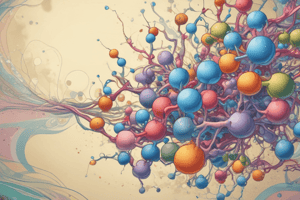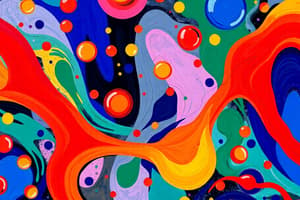Podcast
Questions and Answers
What is the result of uneven sharing of electrons in a polar molecule?
What is the result of uneven sharing of electrons in a polar molecule?
- A slight positive charge on the stronger attracting atom
- A slight negative charge on the stronger attracting atom (correct)
- A slight positive charge on the weaker attracting atom
- A slight negative charge on the weaker attracting atom
Which elements are known to have a strong attraction for electrons and are often found in polar molecules?
Which elements are known to have a strong attraction for electrons and are often found in polar molecules?
- Fluorine and Chlorine
- Nitrogen and Oxygen (correct)
- Helium and Neon
- Carbon and Hydrogen
What is the net charge for a polar molecule like water?
What is the net charge for a polar molecule like water?
- Variable
- Positive
- Zero (correct)
- Negative
What type of bond forms between atoms in neighboring molecules or between atoms in different parts of the same molecule?
What type of bond forms between atoms in neighboring molecules or between atoms in different parts of the same molecule?
What is responsible for the surface tension of water?
What is responsible for the surface tension of water?
What is the result of hydrogen bonding between water molecules?
What is the result of hydrogen bonding between water molecules?
What is the term for the attractive force between water molecules?
What is the term for the attractive force between water molecules?
What is the term for the force that causes water to form spherical droplets or bead up when spilled onto a nonabsorbent surface?
What is the term for the force that causes water to form spherical droplets or bead up when spilled onto a nonabsorbent surface?
What is the characteristic of a saturated fatty acid?
What is the characteristic of a saturated fatty acid?
What is the product of glycerol plus one fatty acid?
What is the product of glycerol plus one fatty acid?
What is the relationship between the saturation of a fatty acid and its physical state?
What is the relationship between the saturation of a fatty acid and its physical state?
What is the difference between a monoglyceride and a diglyceride?
What is the difference between a monoglyceride and a diglyceride?
Which of the following fatty acids is monounsaturated?
Which of the following fatty acids is monounsaturated?
What is the result of glycerol reacting with two fatty acids?
What is the result of glycerol reacting with two fatty acids?
What is the functional group present in glycerol?
What is the functional group present in glycerol?
What is the type of bond between carbons in a saturated fatty acid?
What is the type of bond between carbons in a saturated fatty acid?
What is the approximate percentage of water in the adult human body?
What is the approximate percentage of water in the adult human body?
What is the bond angle of the hydrogen atoms attached to the oxygen in a water molecule?
What is the bond angle of the hydrogen atoms attached to the oxygen in a water molecule?
What type of bonds are responsible for the double helix structure of a DNA molecule?
What type of bonds are responsible for the double helix structure of a DNA molecule?
What is the net charge of the chromium ion usually found in biological systems and dietary supplements?
What is the net charge of the chromium ion usually found in biological systems and dietary supplements?
What is the main function of the hexavalent chromium ion, Cr 6+,?
What is the main function of the hexavalent chromium ion, Cr 6+,?
What is the main characteristic of the shape of a molecule?
What is the main characteristic of the shape of a molecule?
What type of bonds cause the chains to kink or bend in long carbon chain fatty acids?
What type of bonds cause the chains to kink or bend in long carbon chain fatty acids?
What is the main ionic composition of body fluids in the human body?
What is the main ionic composition of body fluids in the human body?
What is the pH range that is incompatible with life?
What is the pH range that is incompatible with life?
What is the name of the diagram used to illustrate protein secondary structure?
What is the name of the diagram used to illustrate protein secondary structure?
What is the source of some hydrogen ions in body fluids?
What is the source of some hydrogen ions in body fluids?
What is the name of the acid produced in the body from CO2 and water?
What is the name of the acid produced in the body from CO2 and water?
What is the significance of a protein's tertiary structure?
What is the significance of a protein's tertiary structure?
What is the characteristic of globular proteins?
What is the characteristic of globular proteins?
What is the result of the spontaneous folding of a protein?
What is the result of the spontaneous folding of a protein?
What is the characteristic of proteins that are categorized as fibrous?
What is the characteristic of proteins that are categorized as fibrous?
What contributes to the tertiary structure of globular proteins?
What contributes to the tertiary structure of globular proteins?
What is the function of buffers in the body?
What is the function of buffers in the body?
What is the role of disulfide bonds in the shape of many globular proteins?
What is the role of disulfide bonds in the shape of many globular proteins?
What is the function of the bicarbonate anion in the human body?
What is the function of the bicarbonate anion in the human body?
What is the characteristic of fibrous proteins?
What is the characteristic of fibrous proteins?
What is the result of adding hydrochloric acid to a sodium bicarbonate solution?
What is the result of adding hydrochloric acid to a sodium bicarbonate solution?
What is the function of cysteine in the formation of disulfide bonds?
What is the function of cysteine in the formation of disulfide bonds?
What is the result of adding free H+ to a buffer solution?
What is the result of adding free H+ to a buffer solution?
Flashcards are hidden until you start studying
Study Notes
Fatty Acids
- Palmitic acid is a saturated fatty acid, meaning it has no double bonds between carbons.
- Saturated fatty acids are likely to be solid at room temperature.
- Glycerol plus one fatty acid produces a monoglyceride.
- Glycerol plus two fatty acids produces a diglyceride.
Polarity
- Saturated fatty acids have no double bonds between carbons, making them "saturated" with hydrogens.
- When electrons are shared unevenly, the atom with a stronger attraction for electrons develops a slight negative charge (d+).
- The atom with a weaker attraction for electrons develops a slight positive charge (d-).
- Polar molecules have positive and negative ends, or poles.
- Hydrogen bonds may occur between atoms in neighboring molecules or between atoms in different parts of the same molecule.
Hydrogen Bonding
- Hydrogen bonding is responsible for the surface tension of water.
- Surface tension is the attractive force between water molecules that causes water to form spherical droplets when falling or to bead up when spilled onto a nonabsorbent surface.
- Hydrogen bonding between molecules makes it difficult to stretch or deform water.
Biological Solutions
- Life as we know it is established on water-based, or aqueous, solutions that resemble dilute seawater in their ionic composition.
- The adult human body is about 60% water.
- Na+, K+, and Cl- are the main ions in body fluids.
Molecular Shape
- Covalent bonds and weak bonds play a critical role in determining molecular shape.
- The three-dimensional shape of a molecule is difficult to show on paper, but many molecules have characteristic shapes due to the angles of covalent bonds between atoms.
- Double bonds in long carbon chain fatty acids cause the chains to kink or bend.
Proteins
- Proteins have a mix of beta strands and alpha helices.
- Protein secondary structure is illustrated by ribbon diagrams.
- The tertiary structure of a protein is its three-dimensional shape, created through spontaneous folding as the result of covalent bonds and noncovalent interactions.
- Globular proteins can be a mix of alpha helices, beta sheets, and amino acid chains that fold back on themselves.
- The tertiary structure of globular proteins arises partly from the angles of covalent bonds between amino acids and partly from hydrogen bonds, van der Waals forces, and ionic bonds that stabilize the molecule's shape.
Hydrogen Ions
- Hydrogen ions in body fluids come from the separation of water molecules (H2O) into H+ and OH- ions.
- Acids, molecules that release H+ when they dissolve in water, are also a source of hydrogen ions.
- Carbonic acid is made in the body from CO2 and water.
- When carbonic acid separates into a bicarbonate ion and a hydrogen ion, only free H+ contributes to the hydrogen ion concentration.
Buffers
- Buffers are substances that moderate changes in pH.
- Many buffers contain anions that have a strong attraction for H+ molecules.
- When free H+ is added to a buffer solution, the buffer's anions bond to the H+, thereby minimizing any change in pH.
- The bicarbonate anion, HCO3-, is an important buffer in the human body.
Studying That Suits You
Use AI to generate personalized quizzes and flashcards to suit your learning preferences.




